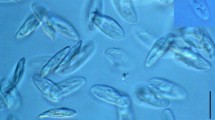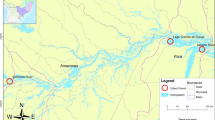Abstract
Myxosporeans Chloromyxum cristatum, Chloromyxum fluviatile and Zschokkella nova (Myxozoa) are common gall bladder parasites of the cyprinid fishes frequently persisting as co-infections. Despite the fact that they are believed to be innocuous endocommensals, C. cristatum clearly displays the potential of a serious pathogen since it may pervade fish liver parenchyma and cause its necrosis. Employing the comparison of genetic distances among the myxosporean rDNA sequences and performing phylogenetic analyses, we demonstrate that cryptic species assemblages exist in C. fluviatile and Z. nova. Sequence comparison revealed that Chloromyxum legeri, previously assigned as a junior synonym of C. fluviatile, is a valid species. The same method is used to display the distinction of Z. nova isolates from China and the Czech Republic. We show that C. cristatum is not an assemblage of more species, and our results support the synonymy of Chloromyxum cyprini with C. cristatum. We have developed a multiplex PCR as an effective tool for the detection and discrimination of Z. nova, C. cristatum, and C. fluviatile. It is especially advantageous for the distinction of the non-mature plasmodia of both Chloromyxum species. This method also helped to assess the exact prevalence of these parasites in examined samples and enabled to select single-infected host samples for the intended population studies.




Similar content being viewed by others
References
Alvarez-Pellitero P, Pereira-Bueno J, Gonzales-Lanza C (1983) Coelozoic myxosporidians (Myxidium spp. and Chloromyxum spp.) of cyprinids from the river Esla (León, NW Spain). I. Description of the species. Angew Parasitol 24:1–14
Bartošová P, Fiala I, Hypša V (2009) Concatenated SSU and LSU rDNA data confirm the main evolutionary trends within myxosporeans (Myxozoa: Myxosporea) and provide an effective tool for their molecular phylogenetics. Mol Phylogenet Evol 53:81–93. doi:10.1016/j.ympev.2009.05.018
Brummer-Konverkontio H, Valtonen ET, Pugachev ON (1991) Myxosporea parasites in roach, Rutilus rutilus (Linnaeus), from four lakes in central Finland. J Fish Biol 38:573–586
Bucher F, Hofer R, El-Matbouli M (1992) Prevalence and pathology of Zschokkella nova (Myxosporea) in the liver of bullhead Cottus gobio from a polluted river. Dis Aquat Org 14:137–143
Chilton NB, Huby-Chilton F, Gasser RB (2003) First complete large subunit ribosomal RNA sequence and secondary structure for a parasitic nematode: phylogenetic and diagnostic implications. Mol Cell Probes 17:33–39. doi:10.1016/S0890-8508(02)00107-X
Dyková I, Lom J (1988) Review of pathogenic myxosporeans in intensive culture of carp (Cyprinus carpio) in Europe. Folia Parasitol 35:289–307
Fiala I (2006) The phylogeny of Myxosporea (Myxozoa) based on small subunit ribosomal RNA gene analysis. Int J Parasitol 36:1521–1534. doi:10.1016/j.ijpara.2006.06.016
Fiala I, Dyková I (2004) The phylogeny of marine and freshwater species of the genus Chloromyxum Mingazzini, 1890 (Myxosporea: Bivalvulida) based on small subunit ribosomal RNA gene sequences. Folia Parasitol 51:211–214
Hallett SL, Atkinson SD, Holt RA, Banner CR, Bartholomew JL (2006) A new myxozoan from feral goldfish (Carassius auratus). J Parasitol 92:357–363
Hassouna N, Michot B, Bachellerie JP (1984) The complete nucleotide sequence of mouse 28 S rRNA gene. Implications for the process of size increase of the large subunit rRNA in higher eukaryotes. Nucleic Acids Res 12:3563–3583
Holzer AS, Sommerville C, Wootten R (2006) Molecular identity, phylogeny and life cycle of Chloromyxum schurovi Shul’man and Ieshko 2003. Parasitol Res 99:90–96. doi:10.1007/s00436-005-0057-z
Jiménez-Guri E, Philippe H, Okamura B, Holland PWH (2007) Buddenbrockia is a cnidarian worm. Science 317:116–118. doi:10.1126/science.1142024
Kepr T (1991) Parasitic Protozoa of cyprinid fishes: protozoa of the roach Rutilus rutilus (Linnaeus, 1758) in Czechoslovakia. Folia Parasitol 38:11–21
Klokacheva S (1914) Ueber die Myxosporidien der Karausche. Zool Anz 44:182–186
Lom J, Dyková I (1992) Protozoan parasites of fishes. Dev Aquacult Fish Sci 26. Elsevier (Amsterdam)
Lom J, Dyková I (1993) Scanning electron microscopic revision of common species of the genus Chloromyxum (Myxozoa: Myxosporea) infecting European freshwater fishes. Folia Parasitol 40:161–174
Lom J, Dyková I (2006) Myxozoan genera: definition and notes on taxonomy, life-cycle terminology and pathogenic species. Folia Parasitol 53:1–36
Maddison WP, Maddison DR (2009) Mesquite: a modular system for evolutionary analysis. Version 2.72. www.mesquiteproject.org
Posada D, Crandall KA (1998) MODELTEST: testing the model of DNA substitution. Bioinformatics 14:817–818
Ronquist F, Huelsenbeck JP (2003) MrBayes 3: bayesian phylogenetic inference under mixed models. Bioinformatics 19:1572–1574. doi:10.1093/bioinformatics/btg180
Shulman SS, Malakhova RP, Rybak VR (1974) A comparative ecological analysis of parasites of fish in lakes of Karelia. Nauka (Leningrad) (in Russian)
Sonnenberg R, Nolte AW, Tautz D (2007) An evaluation of LSU rDNA D1-D2 sequences for their use in species identification. Front Zool 4:6. doi:10.1016/j.ympev.2007.03.025
Swofford DL (2001) PAUP*. Phylogenetic Analysis Using Parsimony (* and Other Methods). Version 4. Sinauer Associates, Sunderland, Massachusetts
Thompson JD, Gibson TJ, Plewniak F, Jeanmougin F, Higgins DG (1997) The Clustal X windows interface: flexible strategies for multiple sequence alignment aided by quality analysis tools. Nucleic Acids Res 24:4876–4882
Acknowledgements
We would like to thank Prof. Iva Dyková (Biology Centre AS CR, Czech Republic) for the gall bladder samples used in this study. Our special thanks belong to Prof. Tomáš Scholz (Biology Centre AS CR, Czech Republic) for his valuable comments. The present study was supported by the Grant Agency of the Academy of Sciences of the Czech Republic (KJB600960701), the Grant Agency of the University of South Bohemia (04-GAJU-43), the research project of the Faculty of Science, University of South Bohemia (MSM 6007665801), the Grant Agency of the Czech Republic (524/03/H133) and research projects of the Institute of Parasitology, Biology Centre of the Czech Academy of Sciences (Z60220518 and LC 522).
Author information
Authors and Affiliations
Corresponding author
Electronic supplementary material
Below is the link to the electronic supplementary material.
ESM 1
An alignment of the concatenated SSU and LSU rDNA data with marked LSU rDNA D regions and primer locations (PDF 1057 kb)
Rights and permissions
About this article
Cite this article
Bartošová, P., Fiala, I. Molecular evidence for the existence of cryptic species assemblages of several myxosporeans (Myxozoa). Parasitol Res 108, 573–583 (2011). https://doi.org/10.1007/s00436-010-2100-y
Received:
Accepted:
Published:
Issue Date:
DOI: https://doi.org/10.1007/s00436-010-2100-y




